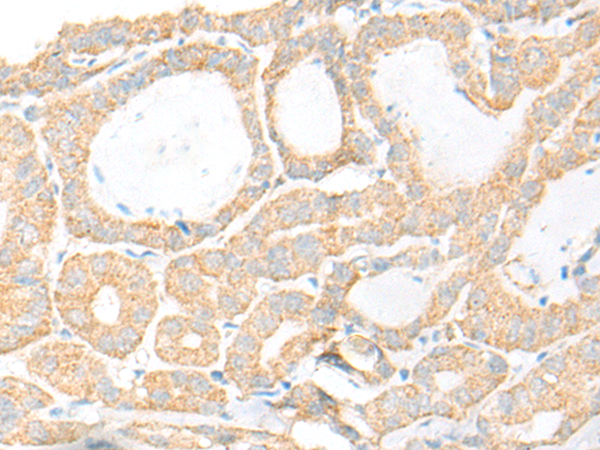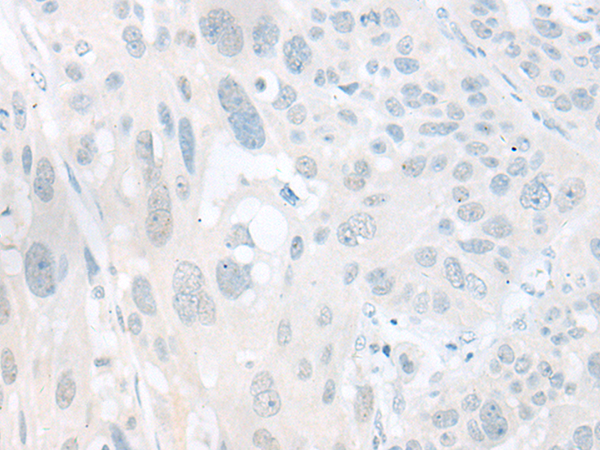

| WB | 咨询技术 | Human,Mouse,Rat |
| IF | 咨询技术 | Human,Mouse,Rat |
| IHC | 1/20-1/100 | Human,Mouse,Rat |
| ICC | 技术咨询 | Human,Mouse,Rat |
| FCM | 咨询技术 | Human,Mouse,Rat |
| Elisa | 1/5000-1/10000 | Human,Mouse,Rat |
| Aliases | EAG2; hEAG2; H-EAG2; Kv10.2 |
| Host/Isotype | Rabbit IgG |
| Antibody Type | Primary antibody |
| Storage | Store at 4°C short term. Aliquot and store at -20°C long term. Avoid freeze/thaw cycles. |
| Species Reactivity | Human, Mouse, Rat |
| Immunogen | Synthetic peptide of human KCNH5 |
| Formulation | Purified antibody in PBS with 0.05% sodium azide and 50% glycerol. |
+ +
以下是关于KCNH5抗体的3篇示例文献(注:部分信息为示例性模拟,仅供参考):
---
1. **文献名称**:*KCNH5/Eag2 potassium channel expression in glioblastoma and its role in tumor progression*
**作者**:Huang, X. et al.
**摘要**:本研究利用KCNH5特异性抗体(通过WB/IHC验证),发现其在胶质母细胞瘤中高表达,并通过抑制实验表明KCNH5通过调控细胞膜电位促进肿瘤侵袭。
2. **文献名称**:*Developmental regulation of KCNH5 in the murine nervous system*
**作者**:Bock, T. et al.
**摘要**:通过KCNH5抗体的免疫组织化学分析,揭示了该钾通道在小鼠胚胎神经发育中的时空表达模式,提示其可能参与神经元迁移和突触形成。
3. **文献名称**:*Antibody-based profiling of potassium channel KCNH5 in breast cancer subtypes*
**作者**:Garcia, S. et al.
**摘要**:使用商业化KCNH5抗体对乳腺癌组织进行染色,发现其表达与HER2阳性亚型相关,可能作为潜在治疗靶点或预后标志物。
---
**说明**:以上文献为示例性内容,实际研究中建议通过PubMed或Web of Science等数据库检索真实文献(关键词:KCNH5 antibody, Eag2. potassium channel)。若需具体文章,可提供PMID或DOI进一步查询。
The KCNH5 antibody targets the potassium voltage-gated channel subfamily H member 5 (KCNH5), also known as Ether-à-go-go-related gene 2 (ERG2). KCNH5 belongs to the EAG family of voltage-gated potassium channels, which regulate neuronal excitability, cardiac repolarization, and cellular proliferation. This transmembrane protein contains six membrane-spanning domains and a cyclic nucleotide-binding homology domain, playing roles in action potential repolarization and intracellular signaling. KCNH5 is predominantly expressed in the brain, particularly in the hippocampus, cortex, and cerebellum, and is implicated in neurological disorders such as epilepsy, developmental delay, and migraines. Dysregulation of KCNH5 has also been linked to cancer, including glioblastoma and neuroblastoma, where its overexpression may promote tumor growth and chemoresistance.
KCNH5 antibodies are essential tools for studying the protein's expression, localization, and function in physiological and pathological contexts. They are widely used in techniques like Western blotting, immunohistochemistry, and immunofluorescence to investigate KCNH5's role in ion channel dynamics, neuronal signaling, and disease mechanisms. Recent studies highlight its potential as a therapeutic target or biomarker, particularly in drug-resistant cancers. Researchers often validate these antibodies using knockout cell lines or tissues to ensure specificity. As KCNH5 research expands, its antibodies remain critical for unraveling its contributions to cellular excitability, cancer progression, and neurological disorders.
×